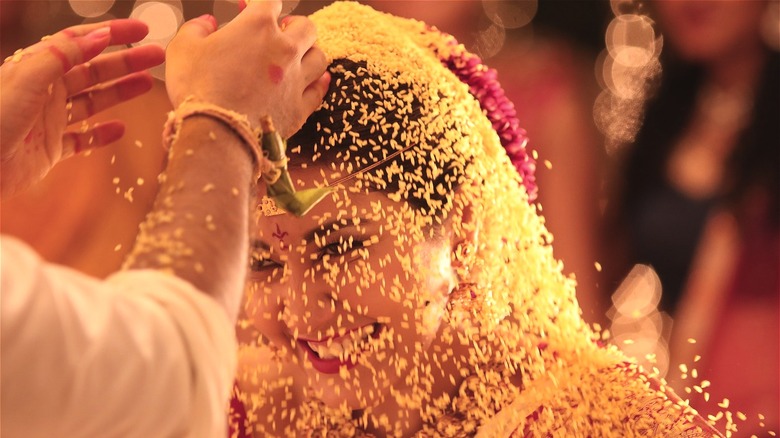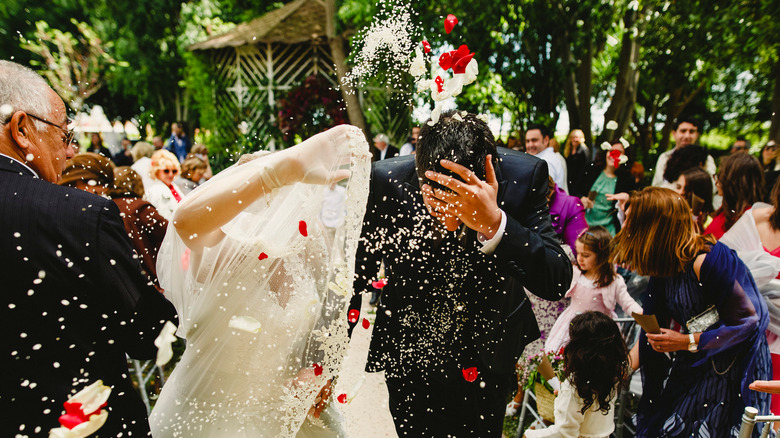Why Do People Throw Rice At The Bride And Groom During A Wedding?
For many newlyweds around the world, walking through a shower of rice on the day of their wedding is a rite of passage. From India to Greece, several countries practice this tradition — or variations of it — which is commonly known as the rice toss.
Brides explains that the practice often takes place after the wedding ceremony, as the couple takes its first steps down the aisle as official spouses. In some cases, where the ceremony venue does not allow rice to be tossed inside, guests might throw it over the newlyweds outside as they leave the venue. The rice toss may also happen at the end of the wedding reception when the couple makes its final exit. Rather than bringing their own rice, guests are provided with rice when they arrive, either at the ceremony or the reception depending on the couple's preference.
Ultimately, there are no set-in-stone rules to follow, and it's up to each couple to decide when and how they'd like to include a rice toss in their wedding. As long as wedding organizers follow the individual rules of their venue, which may ban the throwing of rice, the rice toss is a custom that couples can incorporate however they wish. While in modern times people tend to follow the ritual simply because of tradition, rice was originally tossed with a specific purpose in mind, and its heritage dates back thousands of years.
The long history of throwing rice at weddings
The concept of showering a couple in grain can be traced back at least to the days of Ancient Rome. While the Romans used wheat in the practice, the Celts used various other grains, including oats, rye, and millet (via Celtic Jewelry). As grains in the ancient world were so important to daily life, they became a symbol of prosperity, and so the custom of tossing grain emerged as a way to wish a couple some blessings and good fortune. Grain also came to symbolize fertility; therefore, wedding guests would throw rice and other grains to wish the couple success in having children.
In some societies, the throwing of grain was used as a form of protection. The Celts believed that envious evil spirits would appear at weddings to absorb the joyous energy of the couple and their families and to sabotage their happiness. According to the New Zealand Herald, wedding guests would throw grain, fruit, and nuts at the newlyweds to distract hungry spirits, luring their attention away from handing out curses. The belief in the presence of malevolent energy at weddings also influenced other matrimonial customs over the years, including bridesmaids' dresses, which were initially worn to confuse spirits as to who the bride was, and wedding bells, rung to ward off evil.
How has the rice toss evolved over time?
Like many rituals rooted in the ancient world, the rice toss has evolved over time. These days, couples often opt for alternatives to throwing rice at their wedding, including confetti, sparklers, streamers, and pom poms (via MarthaStewart.com). Some couples also have their guests blow bubbles. The popularity of rice as a wedding custom has declined over the years, in part, due to the false belief that raw rice kills birds that eat it. Project Feederwatch states that many birds eat uncooked rice and this does not harm them. Actually, venues that ban rice often do so because the small grains can be a pain to clean up!
While some cultures still use rice, other countries have shaped their own traditions out of the custom. In Poland, for example, rice is still used but guests also place coins at the couples' feet. In Italy, the couple is showered in sugared almonds, while dried dates or figs are used in Morocco. Hindu weddings still traditionally include the throwing of rice, which is a way for guests to bless the newlyweds (via Borgen Magazine).
Regardless of the ingredients, these cultural formalities stem from the desire to wish fortune on a couple as they begin their marriage journey. Modern couples might not make the connection between grain and prosperity, and having children is no longer a universal goal for every marriage. But whether it be through rice, confetti, or bubbles, the desire to wish happiness on our newly wedded loved ones lives on.


